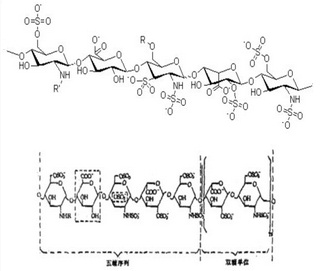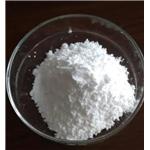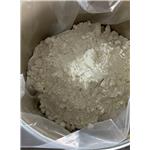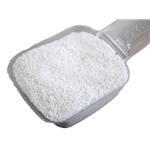Heparin sodium
- CAS No.
- 9041-08-1
- Chemical Name:
- Heparin sodium
- Synonyms
- SODIUM HEPARIN;HEPARIN SODIUM SALT;PORCINE HEPARIN SODIUM;HEPARIN SODIUM INJECTION;Heparin sodium salt (MW 15kDa);LOW MOLECULAR WEIGHT HEPARIN SODIUM;Heparin for physico-chemical analysis CRS;Fragmin;normiflo;Panheprin
- CBNumber:
- CB0439583
- Molecular Formula:
- (C12H16NS2Na3)20
- Molecular Weight:
- 0
- MDL Number:
- MFCD00081689
- MOL File:
- Mol file
- MSDS File:
- SDS
| Melting point | >181°C (dec.) |
|---|---|
| alpha | D25 +47° (c = 1.5 in water) |
| storage temp. | 2-8°C |
| solubility | H2O: 50 mg/mL, clear, faintly yellow |
| form | crystalline (fine) |
| color | white |
| PH | pH (10g/l, 25℃) : 6.0~8.0 |
| Water Solubility | Soluble in water, dimethyl sulfoxide and ethanol. |
| Merck | 14,4653 |
| Stability | Stable. Incompatible with strong oxidizing agents, strong bases. |
| CAS DataBase Reference | 9041-08-1 |
| EWG's Food Scores | 1 |
| NCI Dictionary of Cancer Terms | dalteparin sodium; Fragmin; Innohep |
| FDA UNII | ZZ45AB24CA |
| NCI Drug Dictionary | dalteparin sodium |
| EPA Substance Registry System | Heparin, sodium salt (9041-08-1) |
SAFETY
Risk and Safety Statements
| Symbol(GHS) |  GHS07 |
|||||||||
|---|---|---|---|---|---|---|---|---|---|---|
| Signal word | Warning | |||||||||
| Hazard statements | H315-H319-H335 | |||||||||
| Precautionary statements | P261-P271-P280 | |||||||||
| Risk Statements | 36/37/38-42/43 | |||||||||
| Safety Statements | 22-24-26-36/37 | |||||||||
| WGK Germany | 2 | |||||||||
| RTECS | MI0850000 | |||||||||
| F | 3-10 | |||||||||
| TSCA | Yes | |||||||||
| HS Code | 30019010 | |||||||||
| Toxicity | LD50 oral in rat: > 779000iu/kg | |||||||||
| NFPA 704 |
|
Heparin sodium price More Price(62)
| Manufacturer | Product number | Product description | CAS number | Packaging | Price | Updated | Buy |
|---|---|---|---|---|---|---|---|
| Sigma-Aldrich | H3393 | Heparin sodium salt from porcine intestinal mucosa Grade I-A, ≥180?USP units/mg | 9041-08-1 | 10000UNITS | $43.2 | 2024-03-01 | Buy |
| Sigma-Aldrich | H3393 | Heparin sodium salt from porcine intestinal mucosa Grade I-A, ≥180?USP units/mg | 9041-08-1 | 25000UNITS | $63.4 | 2024-03-01 | Buy |
| Sigma-Aldrich | H3393 | Heparin sodium salt from porcine intestinal mucosa Grade I-A, ≥180?USP units/mg | 9041-08-1 | 50000UNITS | $78.3 | 2024-03-01 | Buy |
| Sigma-Aldrich | H3393 | Heparin sodium salt from porcine intestinal mucosa Grade I-A, ≥180?USP units/mg | 9041-08-1 | 100000UNITS | $108 | 2024-03-01 | Buy |
| Sigma-Aldrich | H3393 | Heparin sodium salt from porcine intestinal mucosa Grade I-A, ≥180?USP units/mg | 9041-08-1 | 250000UNITS | $222 | 2024-03-01 | Buy |
Heparin sodium Chemical Properties,Uses,Production
Anticoagulant drug
Heparin sodium salt, used as an anticoagulant, is a mucopolysaccharide substance, is the sodium salt form of glucosamine sulfate extracted from the intestinal mucosa of pigs, cattle, and sheep. It is secreted by mast cells to be naturally presented the blood inside the human bodies. Heparin can prevent platelet aggregation and destruction, inhibit the conversion from fibrinogen to fibrin monomers, inhibit the formation of thromboplastin and fight against the pre-formed thromboplastin, and also prevent the conversion of prothrombin to thrombin and counteract the antithrombin.
Heparin sodium salt can delay or prevent blood coagulation in vitro and in vivo. Its mechanism of action is very complicated which involves many processes of coagulation process. Its role is to: 1. inhibit the formation and function of thromboplastin, thus preventing the conversion of prothrombin into thrombin; 2. Inhibit the thrombin and other coagulation factors at relative high concentrations, preventing the conversion of fibrinogen to fibrous proteins; 3. prevent platelet aggregation and destruction. In addition, the anticoagulant effect of Heparin sodium salt is still related to the negatively charged sulfate inside its molecule. Positively charged alkaline substance such as protamine or toluidine blue can all neutralize its negative charge, thus inhibiting its anticoagulant effect. Because heparin can be activated in vivo and release lipoprotein lipase, hydrolyzing the triglycerides and low-density lipoprotein in chylomicrons, so it also has a lipid-lowering effect.
Heparin sodium salt can be used for the treatment of acute thromboembolic disease and disseminated intravascular coagulation (DIC). In recent years, it was found that heparin has an effect on blood lipid clearance. Intravenous or deep intramuscular injection (or subcutaneous) for 5,000 to 10,000 units per time is suitable. Heparin sodium salt has a low toxicity with spontaneous bleeding tendency as the major danger of the excessive use of heparin. Oral administration is invalid. Administration by injection is demanded. Intramuscular or subcutaneous injection is highly irritating with allergic reactions occur sometimes. Excess amount can even cause cardiac arrest; occasionally a transient hair loss and diarrhea occurs. In addition, it can also cause spontaneous fractures. Long-term use can sometimes cause thrombosis which may be the consequence of anticoagulation enzyme-III depletion. Patients of bleeding tendency, severe liver and kidney dysfunction, severe hypertension, hemophilia, intracranial hemorrhage, peptic ulcer, pregnant and postpartum, visceral tumors, trauma and post-surgery are not allowed to use Heparin sodium salt.
The above information is edited by the Chemicalbook of Dai Xiongfeng.
Chemical and physical property
Heparin sodium salt is white or almost off-white powder, odorless, hygroscopic; soluble in water; insoluble in ethanol, acetone and other organic solvents. It has a strong negative charge in aqueous solution and can binds to a number of cationic molecules to become molecules complex. Its aqueous solution is stable at pH 7.0.
The molecular structure of heparin
Heparin sodium salt is a sulfate group-containing acidic mucopolysaccharide and is a natural anti-clotting substance. Heparin is the collection of a cluster of acidic mucopolysaccharide of different molecular weight. It is a linear chain molecule containing six or eight saccharide repeating unit with molecular weight being between 3,000 to 30,000 and an average molecular weight of about 15,000.
Heparin sodium salt formula consists of two main structural units:
Structure unit 1: GlcNHR-6-OSO3-GlcA-GlcNSO3-3,6-2-OSO3-IdoA-2-OSO3-GlcNSO3-6-OSO3.
Structure unit 2: IdoA-2-OSO3-GlcNSO3-6-OSO3.
Heparin sodium salt, together with other glycosaminoglycans, forms protein complexes inside the tissue. Thereby heparin preparation process comprises of two steps: extracting heparin-protein complex, and the separation and purification of the heparin.
Heparin molecule contain sulfate groups and carboxyl groups, which is a strong acidic polyanion, and capable of reacting with a cationic salt. These cations include metal cations: Ca2 +, Na +, K +, long-chain pyridine compounds of organic base such as cetyl pyridinium chloride (CPC), strychnine, basic dyes-Azure A, cationic surfactants ( long chain quaternary ammonium salts) such as cetyl trimethyl ammonium bromide; cation exchanger and positively charged proteins such as protamine 0 protein. The N-sulfate groups in Heparin structure are closely related with the anti-clotting effect which will be reduced if the N-sulfate groups are disrupted. N-sulfate group is susceptible to acid hydrolysis and is quite stable under alkaline conditions. The free hydroxyl groups in heparin molecule are esterified whose sulfation will also reduce the anticoagulant. However, acetylation does not affect the anticoagulant activity.

Heparin
Heparin is a mucopolysaccharide sulfuric acid ester type. According to their molecular weight, it can be divided into ordinary heparin and low molecular-weight heparin. Common heparin, namely Heparin sodium salt can be used to make calcium heparin by ion exchange process. Heparin sodium salt has a physical and chemical property of a strong negative charge, and can interfere with multiple aspects of the clotting process. It has anti-clotting effect both in vivo and in vitro. It mainly binds to antithrombin III and enhanced its inhibition effect on activated clotting factor II, IX, X, XI and XII. The consequences involve preventing platelet aggregation and damage; blocking the formation of thromboplastin; preventing the conversion of prothrombin to thrombin; inhibiting thrombin and thereby preventing fibrinogen from becoming fibrin. If sulfate groups are hydrolyzed or neutralized by the strong positive charged protamine, it would lose anticoagulant activity immediately. Moreover, topical application of heparin also has anti-inflammatory and analgesic effects.
The pharmacological effect of calcium heparin is similar with that of Heparin sodium salt. However, the role of anti-clotting factor II a slightly stronger; the role of anti-Factor Xa is weak. Calcium heparin also has pharmacological effects are such as adjusting blood lipid, anti-inflammatory, anti-complement, anti-allergy and immune regulation.
Low molecular weight heparin preparation has a antithrombin III-dependent anti-factor Xa activity. It has inhibitory effects on in vivo and in vitro thrombosis, and the formation of both arterial and venous thrombosis. It can stimulate endothelial cells to release the inhibitor of coagulation pathway of tissue factor and also release the fibrinolysis plasminogen activator. It has little effect on platelet function when exerting its antithrombotic effect, and thus reducing the incidence of bleeding complications.
Reference: Licensed Pharmacist Association, Shanghai, the Shanghai Association of Integrative Medicine organized the compilation; Zhang Yao years, Li Duan, Wang Wenjian as major editor.
Low molecular weight heparin
Low molecular weight heparin is a low molecular-weight dextran sulphate and is a new anticoagulant drug as a short-chain heparin preparation of a variety of depolymerization composition. It has effects of anticoagulant, antithrombotic, anti-inflammatory, anti-tumor and inhibiting the proliferation of mesangial cell and matrix. Major products in current market include dalteparin, enoxaparin sodium, and nadroparin calcium. They are anticoagulant and antithrombotic drugs, usually as a colorless or light yellow transparent liquid.
low molecular weight Heparin sodium salt generally refers to the fraction of heparin with a molecular weight less than 10,000. Compared with the standard heparin, low molecular weight heparin has a strong role of anti-clotting factor X but has a very weak role of anticoagulant II factor and inhibiting the action of thrombin. Thereby this product has a strong antithrombotic effect with less bleeding complications. In addition, there are low molecular weight Heparin sodium salts which have pro-fibrinolytic activity for dissolving the formed fresh thrombus. This kind of drug has a slight inhibition on platelet aggregation and has an antithrombotic effect on the human body. In usual doses, it neither causes significant changes in the overall coagulation index nor prolongs the bleeding time. There is only a small possibility of the reduction of blood platelets. There is also no change in fibrinogen binding. Compared with standard heparin, low molecular weight heparin preparations increased the bioavailability and half-life. Subcutaneous injection can lead to rapid absorption.
Low molecular weight heparin having a significant and long-lasting antithrombotic effect. Its antithrombotic activity is stronger than the anticoagulant activity. Thus there is a relative small risk of simultaneously occurrence of antithrombotic effect and bleeding. Clinical used for:
1. Prevention of deep vein thrombosis and pulmonary embolism.
2. Treatment of acute deep vein thrombosis.
3. Upon hemodialysis or hemofiltration, prevent the occurrence of thrombosis or blood clotting in vitro circulation system.
4. Low molecular weight heparin is suitable for the prevention and treatment of thrombosis of surgery.
Drug Interactions
Heparin should not be combined with double coumarin, nonsteroidal anti-inflammatory drug, dipyridamole, dextran, corticosteroids, uric acid, and urokinase which can exacerbate bleeding; Combination with methimazole and propylthiouracil has a synergistic effect. This product has incompatibility with cefotaxime pyridine, cephalothin, daunorubicin, azithromycin, erythromycin, hyaluronidase, aminoglycoside antibiotics, polymyxin B, vancomycin, hydrocortisone, chlorpromazine, and promethazine.
Precautions
1. Heparin overdose can cause spontaneous bleeding, manifested as mucosal bleeding (hematuria, gastrointestinal bleeding), hemarthrosis and wound bleeding. Thereby, it should be measured for the clotting time or partial thromboplastin time (PTT) during the treatment, coagulation time> 30 minutes or PTT> 100 sec indicates overdose. Immediately stop taking the drugs upon spontaneous bleeding. Upon severe bleeding, we can intravenously inject protamine sulfate to neutralize the Heparin sodium salt sodium with injection speed not exceeding 20mg per minute or injecting 50 mg within 10 minutes being appropriate. Typically, 1mg of protamine in the body can neutralize 100 units of heparin.
2. Intramuscular or subcutaneous injection is highly irritating. Use fine needle in the deep muscle or subcutaneous adipose tissue injection; intramuscular injection can cause local hematoma, should consider to plus 2% procaine hydrochloride solution.
3. Be contraindicated in disease including hemorrhagic diathesis and associated slow-down in blood clotting; be cautious when applying to animals of renal insufficiency, pregnant livestock, postpartum, miscarriage, trauma and post-operative animals.
4. Blood containing Heparin sodium salt cannot be used in the similar agglutination, complement and red blood cell fragility test.
5. Combination with sodium bicarbonate, sodium lactate can promote the anticoagulant effect of Heparin sodium salt.
Calcium Heparin
Calcium heparin has the same role as Heparin sodium salt. Because heparin ultimately take effects in the form of calcium salt in the body, it is more suitable for the physiological property of human to apply calcium salts. Together with its stronger anti-renin activity and anti-aldosterone activity than heparin, as well as the advantage of overcoming the adverse reactions caused by subcutaneous injection of heparin such as bleeding, bruising, local pain, this product will serve as a new alternative for heparin preparations. Its usage and dosage is similar with Heparin sodium salt. High-dose therapy is applied to treatment of acute pulmonary embolism and abnormal elevated acute coagulation, Use a dosage of 30,000 U of intravenous infusion per day with dilution at 5% glucose saline or Ringer's solution. Inject subcutaneously 8,000 to 10,000 U per time and once every 8 hours. Medium dose therapy is suitable for treating disseminated intravascular coagulation or thromboembolic disease. Apply 20000 U daily with intravenous or subcutaneous injection. Inject once every 8 to 12 hours. For the above two kinds of treatments, detection blood clotting time is necessary to determine the heparin dose and frequency of administration. Low-dose therapy is suitable for coronary heart disease, unstable angina, hyperlipidemia, and correcting hyper-coagulation state. The daily amount should be around 5,000 to 10,000 U. Apply subcutaneous injection with 5000 U every 12 hours or 24 hours or 7500 daily. Adverse reactions and precautions are similar with heparin. 1 ml Injection each contains 5000U (40mg), 7500U (60mg), 1 Wan U (80mg). Keep shading and store it at cool places.
Chemical property
White or gray-brown amorphous powder, odorless, tasteless, and hygroscopic. Specific rotation [α] 25D + 47 ° (1.5%, water); easily soluble in water; insoluble in organic solvents such as alcohol, ether, acetone and benzene; LD50 (rat, intravenously) 354mg/kg.
Uses
1. Biochemical studies; used for preventing the conversion of prothrombin into thrombin; has blood anti-thrombosis effect.
2. For the delay and prevention of blood clotting.
3. Heparin sodium salt is a mucopolysaccharides biochemical medicine extracted from porcine small intestinal mucosa with strong anticoagulant activity. Mclcan found it from the liver tissue of dog in the study of the clotting mechanism. Brinkous et al proved that heparin having anticoagulant activity. After the first application of heparin as an anticoagulant in clinical filed, it has drawn worldwide attention. With a strong anticoagulant effect, heparin is the primary choice for prevention and treatment of deep vein thrombosis and other thrombotic diseases. Although has more than 60 years of clinical history, so far people haven’t develop a complete substitute of it and thereby it is still the most important anticoagulant and antithrombotic drug of biochemistry. It has a wide application in pharmacy where it is used for the treatment of acute myocardial infarction and toxin-hepatitis. Combination with ribonucleic acid can further increase the its efficacy on treating hepatitis B. Combined with chemotherapy, it helps prevent the formation of blood clots, lower blood fat and enhance immunity. Low molecular weight heparin has anticoagulant Factor Xa activity. Pharmacodynamic studies have shown that low molecular weight heparin has inhibitory effect on both in vivo and in vitro thrombosis and arterial-venous thrombosis but has less impact on blood coagulation and fibrinolysis system. There is a low possibility of bleeding when it produces antithrombotic effect.
Ordinary heparin is a mixture containing a variety of amino dextran glycosides. It can delay or prevent blood coagulation both in vitro and in vivo. Its anticoagulant mechanism is very complicated, and has a role in all processes of blood coagulation including inhibiting the conversion of prothrombin into thrombin; inhibition of thrombin activity; prevent conversion of fibrinogen into fibrin; prevent platelet aggregation and destruction. Heparin can also reduce cholesterol, lower LDL and VLDL, increase HDL, change blood viscosity, protect vascular endothelial cells, prevent atherosclerosis, boost blood flow, and improve coronary circulation.
Production method
Extract the intestinal mucosa of pigs, sheep, and cattle, refine to obtain it.
Description
Reviparin sodium, a second-generation low molecular weight heparin produced from porcine mucosal heparin, has been introduced for the prevention of deep vein thrombosis and pulmonary embolism following surgery. It has sustained activity and increased bioavailability over unfractioned heparin. More noticeably, reviparin shows a pronounced inhibitory effect, both in vitro and in vivo , on smooth muscle cell proliferation which plays a predominant role in restenosis following angioplasty. Indeed, a lower incidence of restenosis without major bleeding complications has been reported for reviparin treated patients who successfully underwent percutaneous transluminal coronary angioplasty.
Chemical Properties
off-white powder
Originator
Knoll (Germany)
Uses
Heparin sodium salt is used as a blood anti-coagulant. It is also used as an effective inhibitor of mesenchymal cell proliferation. Further, it binds to antithrombin III, which inhibits coagulation proteases. It is used as a major component of serum free media for preventing cell aggregation. It is also used as an anti-cancer agent in in vitro cancer research.
Uses
for coagulation proteins, nucleic acids
Uses
corrosive moisture sensitive
Manufacturing Process
Heparinic acid a highly acidic mucopolysaccharide formed of equal parts of
sulfated D-glucosamine and D-glucuronic acid with sulfaminic bridges. The
molecular weight ranges from six to twenty thousand. Heparin occurs in and is
obtained from liver, lung, mast cells, etc., of vertebrates. Its function is
unknown, but it is used to prevent blood clotting in vivo and vitro, in the form
of many different salts.
In a self-regulated process for depolymerizing a heparin in an aqueous
solution by providing about 0.02 to 0.1 M nitrous acid and a pH of about 2 to
3 in said solution, so that process occurs when all the nitrous acid has been
consumed and mucopolysaccharides are produced from the heparin having an
average molecular weight of less than 6,000. Heparin has molecular weight
from 2000 to 50000. The products obtained by a below described method are
constituted by a major part of species of molecular weight of about 2,000 to
8,000, which corresponds to structures having from about 8 to 40 saccharide
entities (the molecular weights are measured by the HPLC method, by means,
for example, of a 0.5 M sodium sulphate buffer).
Self-Regulated Depolymerization of Heparin and Production of MPS of Low
Molecular Weight.
Into 15 liters of distilled water at +20°C, 1,500 grams of commercial heparin
having a YW/USP ratio in the vicinity of 1 and a USP titer of 160 iu, are
dissolved. 51.8 g of sodium nitrate dissolved in 300 ml of distilled water are
added, and immediately the pH is lowered to 2.5 by pure hydrochloric acid.
The reaction then takes place and its progress is checked until the absence of
nitrous ions. After 40 minutes, the presence or absence of nitrous ions is
checked at regular intervals in the reaction medium. Starch-iodine paper, for
example, is used, checking every 5 minutes. After about 60 minutes of
reaction, the nitrous acid had been entirely consumed and no more NO2
- ions
remained in the reaction medium. The pH was then adjusted to 7 with pure
caustic soda, and the products of the reaction were recovered by the addition
of 31 liters of pure ethanol (2 volumes). The precipitate formed was collected
by centrifugation, washed with ethanol and dried at 60°C under vacuum.
1,200 g of products having the following characteristics were collected: USP
titer: 19 μ/mg; APTT titer: 13 μ/mg; Yin and Wessler titer: 202 μ/mg.
In 10 liters of distilled water, at room temperature (15°-20°C) 1,000 grams of
commercial injectable heparin having a USP titer of 170 μ/mg and a YW titer
of 160 μ/mg, are dissolved. 38 g of sodium nitrite (final molarity 0.055 M)
dissolved in 200 ml of water, is added. The pH is immediately lowered to 2.5
by pure hydrochloric acid. The reaction is checked as above at regular
intervals of time (5-10 minutes). After 30 minutes, NO2
- ions are no longer
detected in the reaction medium. The pH is then adjusted to 7 with 5 N soda;
the products of the reaction are recovered by the addition of 21 liters of pure
ethanol (2 volumes). The precipitate formed is collected by centrifugation,
washed with ethanol and dried at 60°C under vacuum. Finally there are
obtained 780 grams of white coloured powder having the following
characteristics: USP Titer: 22 μ/mg; Yin and Wessler Titer: 260 μ/mg; APTT
Titer: 10 μ/mg. Content of nitrites-nitrates: 5 ppm: <4 ppm. Average
molecular weight: less than 6,000. Percentage of species whose molecular
weight exceeds 10,000: less than 1%.
brand name
Normiflo (Pharmacia & Upjohn);Clivarin.
Therapeutic Function
Anticoagulant, Antithrombotic
General Description
Heparin is mainly responsible for the delay in the coagulation of blood. It enhances the antithrombin-mediated inactivation of proteases in the coagulation pathway.
Veterinary Drugs and Treatments
Heparin’s primary uses in small animal medicine has included
treatment of Disseminated
Intravascular Coagulation (DIC) and
prophylaxis of thromboembolic disease. In horses, it has been used
in the treatment of DIC and as prophylactic therapy for laminitis
(unproven efficacy).
Use for treating DIC has become increasingly controversial. The
most recent evidence suggests that heparin not be used during DIC
in patients with concurrent inflammatory processes.
storage
Desiccate at RT
Purification Methods
Dissolve the salt in 0.1M NaCl (1g/100mL) and precipitate it by additing EtOH (150mL). [Wolfrom et al. J Org Chem 29 540 1946, Huggard Adv Carbohydr Chem 10 336-368 1955.]
Heparin sodium Preparation Products And Raw materials
| Supplier | Tel | Country | ProdList | Advantage | |
|---|---|---|---|---|---|
| Hubei Xindesheng Material Technology Co., Ltd. | +8618971041571 | vickyzhao@whdschem.com | China | 174 | 58 |
| Hebei Lingding Biotechnology Co., Ltd. | +86-18031140164 +86-19933155420 | erin@hbldbiotech.com | China | 878 | 58 |
| Guangzhou TongYi biochemistry technology Co.,LTD | +8613073028829 | mack@tongyon.com | China | 2996 | 58 |
| Guangzhou Tengyue Chemical Co., Ltd. | +86-86-18148706580 +8618826483838 | evan@tyvovo.com | China | 152 | 58 |
| Hebei Jingbo New Material Technology Co., Ltd | +8619931165850 | hbjbtech@163.com | China | 1000 | 58 |
| Sigma Audley | +86-18336680971 +86-18126314766 | nova@sh-teruiop.com | China | 524 | 58 |
| Shaanxi TNJONE Pharmaceutical Co., Ltd | +86-13474506593 +86-13474506593 | sarah@tnjone.com | China | 848 | 58 |
| Capot Chemical Co.,Ltd. | 571-85586718 +8613336195806 | sales@capotchem.com | China | 29797 | 60 |
| Henan Tianfu Chemical Co.,Ltd. | +86-0371-55170693 +86-19937530512 | info@tianfuchem.com | China | 21695 | 55 |
| Hangzhou FandaChem Co.,Ltd. | 008657128800458; +8615858145714 | fandachem@gmail.com | China | 9350 | 55 |
Related articles
- The performance of heparin sodium
- Heparin sodium is a mixture of asymmetric molecules with different molecular weights, and is a general name for a class of glu....
- Feb 24,2022
View Lastest Price from Heparin sodium manufacturers
| Image | Update time | Product | Price | Min. Order | Purity | Supply Ability | Manufacturer | |
|---|---|---|---|---|---|---|---|---|
 |
2024-04-19 | Heparin sodium
9041-08-1
|
US $0.00 / kg | 1kg | 99% | 20tons | Shaanxi TNJONE Pharmaceutical Co., Ltd | |
 |
2024-03-19 | Heparin sodium
9041-08-1
|
US $45.00-35.00 / kg | 1kg | 99.8% | 200tons/year | Sigma Audley | |
 |
2023-12-25 | Heparin sodium
9041-08-1
|
US $8.00 / kg | 1kg | 99% | 200000 | Hebei Jingbo New Material Technology Co., Ltd |
-

- Heparin sodium
9041-08-1
- US $0.00 / kg
- 99%
- Shaanxi TNJONE Pharmaceutical Co., Ltd
-

- Heparin sodium
9041-08-1
- US $45.00-35.00 / kg
- 99.8%
- Sigma Audley
-

- Heparin sodium
9041-08-1
- US $8.00 / kg
- 99%
- Hebei Jingbo New Material Technology Co., Ltd




